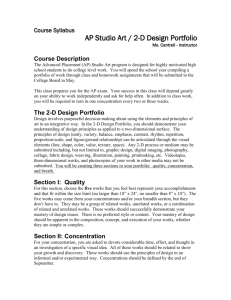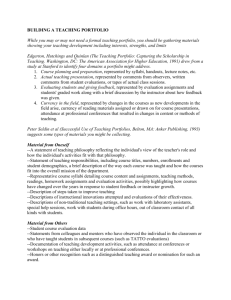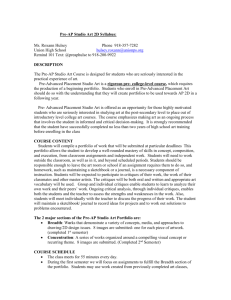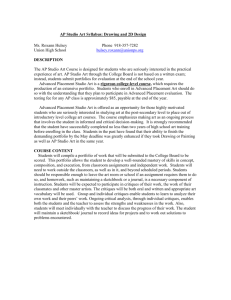AP 2D Design Syllabus
advertisement
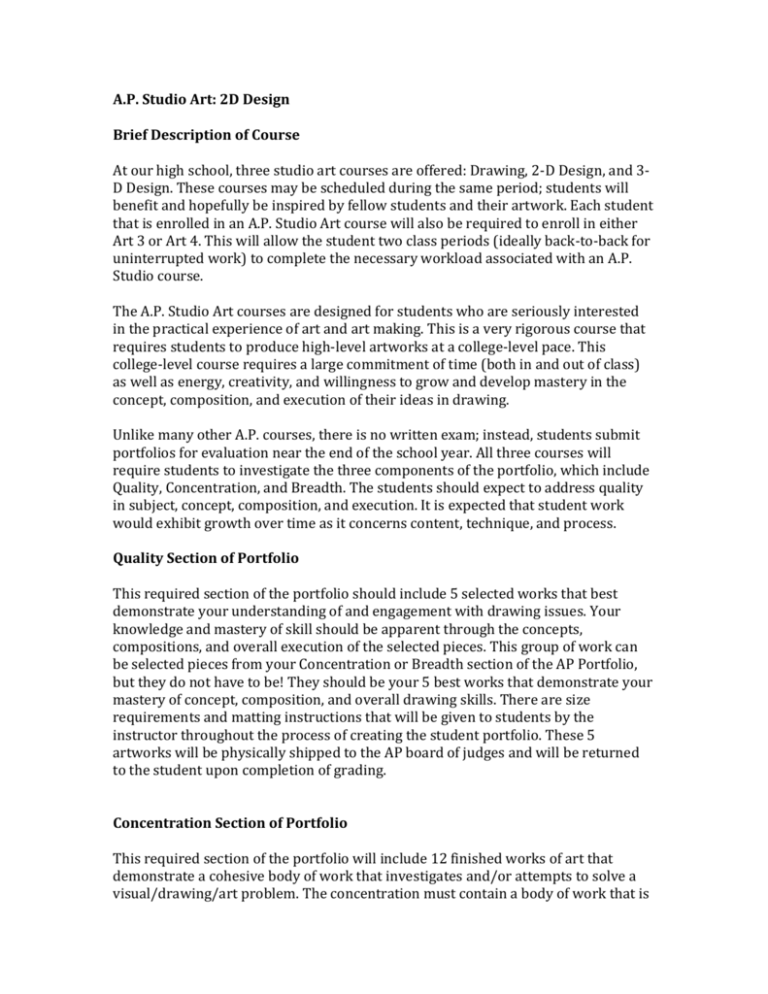
A.P. Studio Art: 2D Design Brief Description of Course At our high school, three studio art courses are offered: Drawing, 2-D Design, and 3D Design. These courses may be scheduled during the same period; students will benefit and hopefully be inspired by fellow students and their artwork. Each student that is enrolled in an A.P. Studio Art course will also be required to enroll in either Art 3 or Art 4. This will allow the student two class periods (ideally back-to-back for uninterrupted work) to complete the necessary workload associated with an A.P. Studio course. The A.P. Studio Art courses are designed for students who are seriously interested in the practical experience of art and art making. This is a very rigorous course that requires students to produce high-level artworks at a college-level pace. This college-level course requires a large commitment of time (both in and out of class) as well as energy, creativity, and willingness to grow and develop mastery in the concept, composition, and execution of their ideas in drawing. Unlike many other A.P. courses, there is no written exam; instead, students submit portfolios for evaluation near the end of the school year. All three courses will require students to investigate the three components of the portfolio, which include Quality, Concentration, and Breadth. The students should expect to address quality in subject, concept, composition, and execution. It is expected that student work would exhibit growth over time as it concerns content, technique, and process. Quality Section of Portfolio This required section of the portfolio should include 5 selected works that best demonstrate your understanding of and engagement with drawing issues. Your knowledge and mastery of skill should be apparent through the concepts, compositions, and overall execution of the selected pieces. This group of work can be selected pieces from your Concentration or Breadth section of the AP Portfolio, but they do not have to be! They should be your 5 best works that demonstrate your mastery of concept, composition, and overall drawing skills. There are size requirements and matting instructions that will be given to students by the instructor throughout the process of creating the student portfolio. These 5 artworks will be physically shipped to the AP board of judges and will be returned to the student upon completion of grading. Concentration Section of Portfolio This required section of the portfolio will include 12 finished works of art that demonstrate a cohesive body of work that investigates and/or attempts to solve a visual/drawing/art problem. The concentration must contain a body of work that is developed from a sustained plan of action or investigation of a visual idea in drawing. The concentration section will be ongoing throughout the year – in the early months of the school year each student will meet with the instructor to talk about ideas and inspirations for a potential concentration theme. At that time a general “plan of attack” will be formed between the student and instructor. Students will be required to research their topics, take source photos, find color inspirations, choose a variety of mediums they believe will work with their concept, and come up with a general idea of their 12 artworks and how they will form together and flow cohesively. At the end of the first semester the student will meet with the instructor again to view progress in research, sketches, etc. At this point the student will begin to constructs artworks and have regular critiques with both fellow students and the instructor regarding progress. Breadth Section of Portfolio This required section of the AP portfolio will include 12 finished works of art. The student will experiment with a variety of concepts and approaches that will allow them to demonstrate a range of abilities and versatility with ideation, problem solving, and various techniques. These 12 pieces can include an extensive exploration of one medium or several media. The Breadth section can be composed of both assigned class work/projects and outside/individual projects. Ideally the student will have a few works compiled from the summer assignments and will then continue to grow and experiment with various media during the beginning of the year. This process will allow the students to not only learn different media and techniques, but will also help to create overall mastery. By exploring the Breadth section first, the student may also begin to identify ideas, themes, and media with which they have a strong personal connection. That connection could spark a potential Concentration concept. Unit Information Students will be expected to complete several assignments over the summer months. These projects will be evaluated and discussed during the first week. Assignment lists will vary by the studio course chosen and will be discussed during May/June of the previous school year. Students will be expected to continue work in their sketchbooks in order to develop ideas and skills. Students will also be encouraged to collect images of inspiration and take photographs of interesting compositions. During the first two quarters students will focus on completing the breadth section of their portfolio. Students will be encouraged to use various media and explore different techniques and concepts to solve visual problems and ideas. By experimenting with new media and techniques the student will be able to demonstrate a range of abilities and versatility in their artwork. Sometime during the second quarter students will begin to investigate the subject of developing a body of related works (concentration). Students should have their concentration idea confirmed before Winter Break so they can do research and collect images/ideas before returning to school. Students will also be required to help in the construction of their physical portfolio as well as the digital images that will be required for submission. Any student enrolled in A.P. Studio Art will be required to participate in multiple critique sessions. These critiques will take various forms – some formal and with a group, others more informal and one-on-one. Critiques may take place while an artwork is being made (working critique) or at the completion of an artwork. These critiques will offer an opportunity to view and judge one’s own work as well as the work of others. Hopefully it will allow students to see areas for improvement as well as find inspiration in the work of others. Content/Skills Addressed/Expectations: Students must understand that this course is structured like a college introductory level studio course. It is rigorous and demanding! Each student will need to be selfmotivated and seriously interested in the study and exploration of art! By the end of the course each student should have the completed artworks to build his/her AP Portfolio, but more importantly the student will hopefully obtain mastery in concept, composition, and execution of their given area of study (2D Design, Drawing, and/or 3D Design). Students will know and be able to apply the art elements and principles of design to their personal artwork. They will also be confident in originating an art concept or idea and taking it from a thought to a wellcrafted piece of art. No matter what AP Portfolio course was chosen, students will experiment with various media such as drawing (pencil, crayon, marker, sharpie, colored pencil, dry pastel, oil pastel, etc.), painting (acrylic, tempera, watercolor, tea/coffee, etc.), 2D Design (graphics, typography, collage, photography, printmaking, etc.), and 3D media (clay, wire, plaster, burlap, found material, etc.). Out of Class Assignments: Due to the challenging pace of this course it will be expected that students will spend 6-8 hours each week on out-of-class assignments, research, and brainstorming. Students should expect to have required summer assignments as well as projects to complete over school breaks, etc. Open Studio: All AP Studio students are welcomed and encouraged to attend the Open Studio hours provided by the instructor on Tuesdays (after school until 5:00 p.m.). This will provide the students time outside of class to work on projects that may require equipment or materials that are unavailable outside of the classroom. Critiques: Each student will participate in both “working critiques” and “final critiques” with the other students and one-on-one with the instructor. During these critiques it is expected that students will use art vocabulary and terms to talk intelligently about not only their own personal work but also the work of others. Artistic Integrity/Plagiarism: Students will be made aware of and study the idea and culture of artistic integrity, plagiarism, and copyright. Students are expected and directed to create their own work! Students will be instructed to work either from direct observation (preferred), dreams, fantasies, life experiences, landscapes, or their OWN photographic compositions and designs. Borrowing ideas or images from other artists, published or non-published photographs, or other images from the Internet is not allowed. Those are not your ideas or your work! Any artwork based on the work of another artist or an image found on the Internet must move FAR beyond simple duplication and address your own personal ideas, vision, and voice in both content and composition in order to be considered an original idea! Sketchbook: Students will be required to keep a sketchbook throughout both the summer months as well as the academic year. This will be used to explore project ideas, hone technical drawing and observation skills, gather inspirational images/colors/ideas, as well as a creative writing outlet. Students will be given a multitude of “sketchbook assignments” and can choose to follow those prompts or create their own! The sketchbooks will become a source of inspiration and experimentation. Students will be asked to work in various mediums such as pencil, sharpie, marker, pastel, collage, paint, etc. If students choose to focus in on one medium (for example pencil) they will be required to show a large variety of techniques and styles with the medium. Grade Breakdown: Students will be awarded points based on 3 categories: Projects/Performance Assessment, participation/attitude/effort, and Portfolio Preparation. The project section will account for 70% of the grade, Portfolio Preparation 15%, and participation/attitude/effort 15%. Major Assignments and/or Assessments: Due to the independent nature of this course very few rigid assignments will be given. The work for the Breadth section can come from “course work” or assigned projects. Even these project ideas are open to interpretation and freedom. As the instructor it is my hope that each student will have their own ideas and desires to create their own artwork, but if needed, direction will be given for the Breadth section. The Concentration portion of the portfolio MUST be created from original, studentcreated thoughts, statements, and ideas. The instructor can help to narrow ideas and critique work, but concentration ideas need to originate from the students! The following is a list of possible project ideas to explore. Each of these are open to interpretation and should allow the students to take the concept and run with their own personal ideas. Nearly all of these assignments could be interpreted in 2D or 3D form. Be creative! Experiment with new media, techniques, and concepts! Assignment Ideas: - Mini Portfolio – 3 works the are related by an idea (biggest size is 5x8) My life in a box – literal or figurative Transformation – could be a series or one piece Create a work using an unusual surface (45 record, CD, Styrofoam, burlap, carpet square, egg carton, etc. BE CREATIVE!) White pastel on black paper – Draw the highlights, leave the shadows! Three zippers – what do they reveal? What do they hide? White on white still life Choose an object, create 5 small works that show the detail, function, use, etc. Series of portraits of one person in your life (show different parts of their personality,) Illustrate your favorite quote without using any words Create an image from text alone, be sure to include value! Illustrate each of the 5 senses (sight, hearing, smell, touch, taste) Create an artwork using an unusual medium (ketchup, mustard, coffee, tea, buttons, stamps, etc.) Illustrate lyrics from your favorite song – NO WORDS allowed! Masks – explore the idea of what you hide with a mask, what do you want people to see, what do you want them to believe? Magnified – find an interesting texture/object and magnify it to the point of abstraction – think O’Keefe flowers, etc. Repetition – create an artwork based on repetition Motion – illustrate motion (could be abstract) Series of portraits with distorted faces (smashed against a window, scrunched up nose, etc. Be creative!) Patterns in nature, series of three Choose a current social issue (Ex: bullying, homelessness, equality, etc.) and create a series of works to advocate one side of the issue Illustrate a word in 5 different ways Silhouette – strong image/concept that is read without any details of figure Madalas – kaleidoscopes, symmetry, balance, repetition, etc. Self Portrait – consider unique views of yourself, work from direct observation (mirrors/other reflective surfaces), think about costume, masks, make-up, etc. Create an interesting background – NO FLOATING HEADS - Metamorphosis – create a visual description of one object transforming into another object Choose a social issue (homelessness, literacy, equal rights, hunger issues, AIDS, bullying, depression, suicide, racism, etc.) and create a poster advocating the subject Political cartoons portraying current events Make a piece of art with at least 3 different media – one wet, one dry, and collage materials Futuristic cityscapes (think year 3000) “Sew” material onto various surfaces that can be painted or drawn on…find ways to connect the different surfaces Cut paper self portraits, interiors, landscapes Visual puns – illustrate your favorite pun Read the fortune on a fortune cookie and create an artwork inspired from its words! Altered books Study of positive vs. negative space Wire sculptures Fruit/Vegetable Still Life – series of drawings from ripe to rotten? Alternative Clothing – use duct tape to make a vest, magazine strips to make a coat, etc. Self-Assessment/Instructor Assessment Tools: Each student will do a post-project self-assessment. This practice will teach them how to critique their artwork as well as write about their work. The following rubric will be used for the AP Studio Course. Score Criteria Craftsmanship: Overall quality of work, use of materials 6: Outstanding Consistency, finished, polished work. Continuous hard work. 4-5: Excellent Finished well. Above average craftsmanship. Evidence of hard work. 3-4: Strong Adequate craftsmanship but lacks finishing touches. Design/Composition Carefully planned and executed. Interesting layout, draws viewer in Attempt at planning but very average execution. Layout could be more interesting. Originality/Creativity Evidence of complete original thought. Took risks, used imagination and executed well. Evidence of planning and above average execution. Interesting layout, but with a few changes could be outstanding Some evidence of original thought. Imagination and creativity involved. Some risk taken with some execution. Commitment/Attitude Evidence of hard work far beyond what is required. Pride is work is evident. Work exceeds the requirements of the assignment. Work is innovative Lesson Objectives Student worked hard and completed the assignment. Pride is evident. Work is complete and shows some areas of going beyond the requirements. Some innovation. Some ideas and/or images were taken from other sources rather than created, although there was an attempt to recreate in an original way. Less risks taken overall. Average time and energy spent on assignment. Student missed some areas to make work shine. The work is complete and meets all requirements. 0-2: Needs Work Below average craftsmanship. A lack of focus, commitment, or lack of understanding is evident. Little evidence of planned work with little execution. Work is unorganized and/or incomplete. Little evidence of original thought or creativity. No risks taken. Overall result is below average. Minimum energy put forth. Work was inadequate and lackluster. The work as turned in is incomplete or late. Students will also answer the following questions for each completed assignment: 1. Description: What do you see? 2. Analysis: How is your work organized? Why did you choose this format? 3. Interpretation: What do you think people will see when they view your work? 4. Judgment: Is this work successful? 5. Innovation/Risk-Taking: What were the risks that you took with this project? Did they yield a successful result? Why? Textbooks Available: Title: Art Talk Publisher: Glencoe/McGraw-Hill Author: Rosalind Ragans Description: High school art textbook, available to all students Title: Launching the Imagination Publisher: McGraw-Hill Author: Mary Stewart Description: College level design text for 2D and 3D Title: Art History: Second Edition Publisher: Prentice Hall Published Date: 2001 Author: Marilyn Stokstad Description: Basic college level art history textbook **There are numerous reference materials available in the art room for both the teacher and student use. **There are 2 computers available for research as well as a 30 unit portable lab available when needed. **Most consumable supplies are provided by the school. Students in all classes are charged an art fee and receive supplies that are theirs to keep and use.

